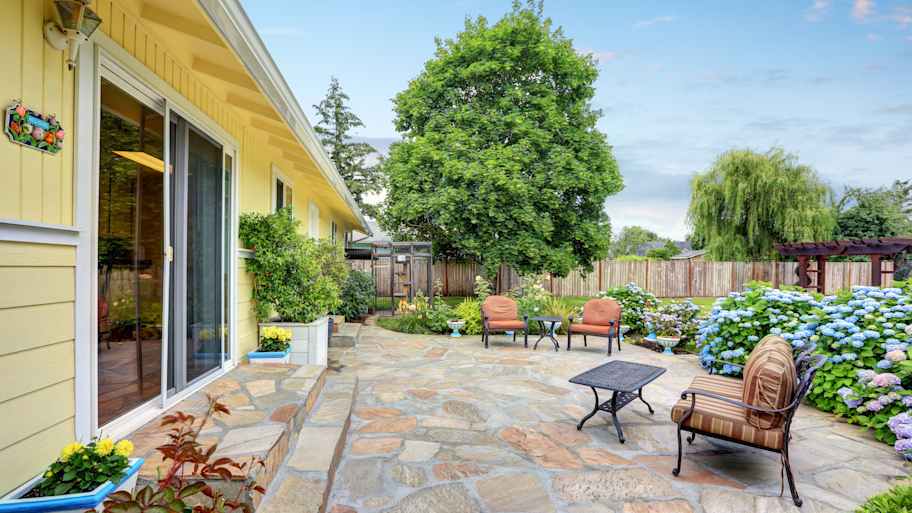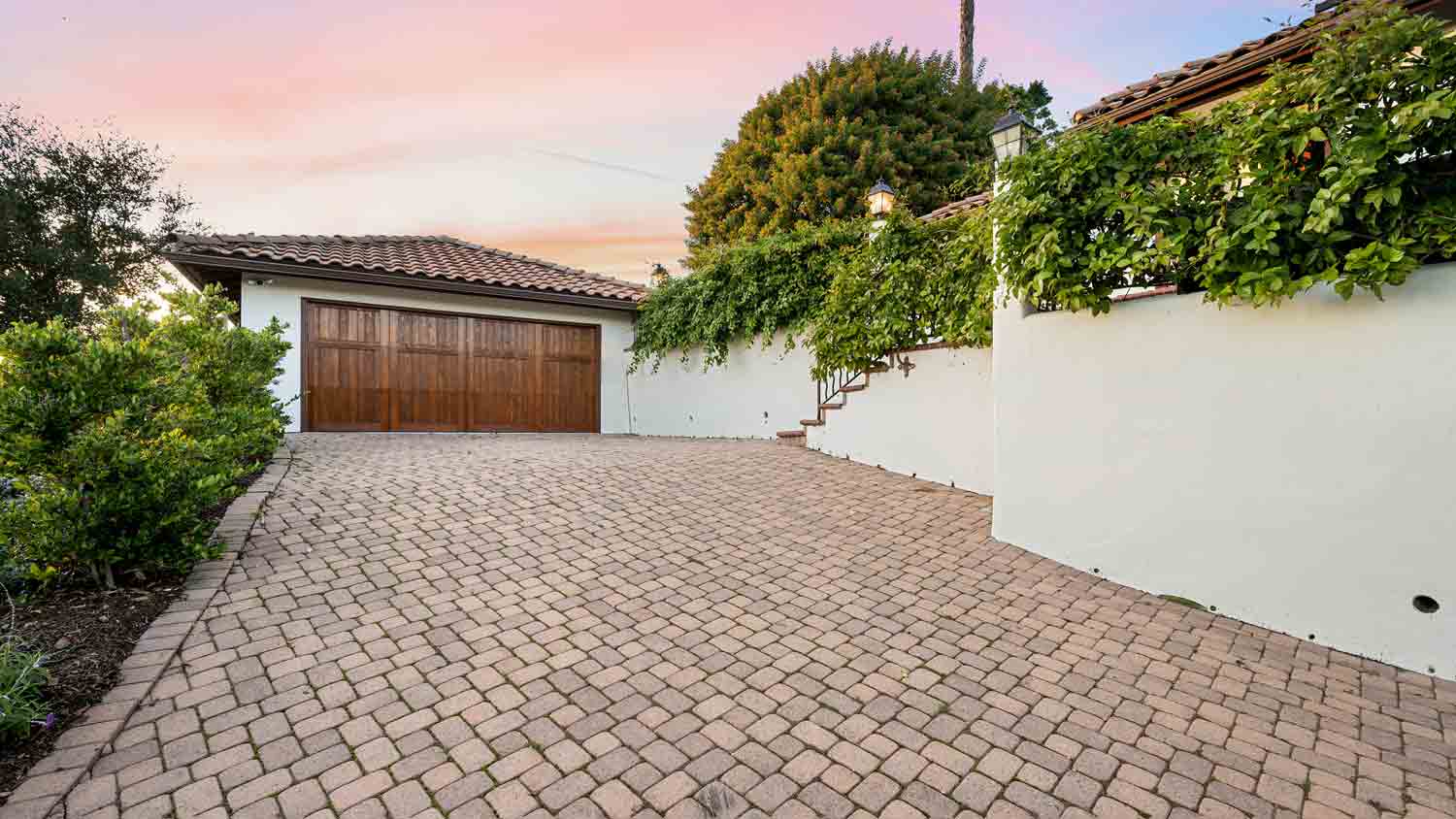
Kick erosion to the curb with an eye-catching retaining wall. Retaining wall costs vary based on the material, but this guide will help you budget.
Enhance your backyard’s charm with a traditional stepping stone path


Stepping stones provide the perfect walkway for the hop, skip, and jump from the back gate to the back door. Or through the garden. Or to the deck. The possibilities for adding charm and color to your backyard are endless. Here’s what to do to prepare for your stepping stone path.
Because it’s fun to come up with stepping stone walkway ideas, you may just want to jump right into the planning and design process. However, you need to take a few steps before you can fully commit to starting the project.
Before digging, call 811 to get the locations of buried utility lines marked, so you can work around them. The location of buried lines might mean adjusting your pathway. You need to allow at least two full business days for the 811 team to mark your property before you begin digging.
If you dig and hit an underground utility line, you could receive a fine of several hundred dollars.
Additionally, if you have underground sprinklers, you need to be careful about where you dig, so you don’t damage the buried sprinkler lines.
If you are digging near any lines or pipes, use a rounded shovel or one with a blunt edge. Dig with as little force as possible, as the markings may not be perfectly accurate.
Avoid starting the project on a day when rain is in the forecast. Rain can wash away base materials and create mud that sticks to everything.
If you don’t mind working with mud, you can lay the stones in drizzle or mist. Light rain should not affect the sand being used as the base material, either. In fact, it may help to compact it.
Digging is certainly easier when the ground is damp, so you may want to start the job after it rains the previous day or after lightly watering the area with a sprinkler a day or two earlier.
Learning how to build stone steps on a slope can be a challenge versus doing the job on flat ground. You’ll have to create tiers on the side of the hill, so you can lay the stone flat and keep it level. If this seems too difficult, you may want to select a different path or hire a professional.

The first step is to choose where your walkway should lead. This will help you determine what clearing needs to be done and what supplies you need.
Will it be a winding path through the garden to nowhere in particular? Or will it be a utilitarian path leading to the outdoor kitchen? Here are a few things to keep in mind as you plan:
In the warmer months, dark-colored stones will be hot on bare feet.
Stones with some texture will be less slippery when wet, or when carrying food and drinks to the outdoor kitchen.
If you’re planning side-by-side strolls through your property, you’ll need a path at least 48 inches wide to accommodate two people.
Before you get to the heavy lifting, use wooden stakes and string to plan the location of your walkway. Just plant a stake and wind the string around it to get an idea and work around any obstacles.
Once you’re happy with your path, determine how far apart you want to space your stepping stones, so you know how many you’ll need. Aim for it to be at least 36 inches wide, or 48 inches wide to allow for two people to walk side-by-side.
Depending on the ground cover, you might need to clear any grass, weeds, or bushes along the pathway. Use an herbicide to keep the plants at bay. You might need to reapply a day or two later.
Dig a trench about 7 inches to 8 inches deep, using a spade to remove rocks and sod.
This step does require quite a bit of physical labor, so give yourself several days to complete the work. If possible, grab a friend or two to help you out. And don’t forget to hydrate! If you find this to be too much of a lift, you can always call a local landscaper to help you out.

Once you finish digging the trench, you need to flatten down the soil. The easiest and fastest way to do this is to rent a plate compactor for about $60. Once your muscles recover from digging the trench, you can use a hand tamper. You’ll probably need a hand tamper to hit any small areas.
Add a layer of gravel that’s at least 3 inches to 6 inches deep for a base. This will help level your pathway and lock your stones in place. Use a steel rake to spread an even layer of gravel.
Once you add your base layer, you need to compact it down. Wet the gravel with a hose and use your plate compactor and hand tamper to tightly compact it down. Repeat this process as necessary until you have a solid layer of gravel that is slightly below ground level.
You’re getting closer to stone time! Next, dump a layer of sand about 3 inches deep on top of your compacted gravel. Use your plate compactor and hand tamper again to pack it down. Create a slight slope, so rainwater will run away from your home and won’t pool in the middle of your pathway.

It’s time! Use your hose’s mist setting to slightly wet the sand, then lay your paver stones down in the desired pattern. Add extra sand to make any necessary adjustments and maintain the slope.
Remember that stepping stones are heavy. If you can, use a cart, dolly, or wheelbarrow to move the stones to your work area. Stretch first, lift with your knees, and take frequent breaks.
Keep your carefully laid stepping stones in place with plastic paver edging. Most kits will contain spikes to secure the edging.

Add a final one-half-inch layer of sand over the stepping stones and grab your tamper one last time to compact it down to fill in the spaces between stones. This will help keep them snug and in place.
Finally, all you need to do is sweep up loose sand and enjoy a stroll down your newly installed pathway.
Although creating a stepping stone path is a potential DIY job, you might prefer hiring a local stone paver installer to do the work. For a little extra money, these installers may be able to calculate the number of stones you need and transport them for you, too.
Expect to pay about $600 to $1,200 for labor and materials for an average flagstone path length of about 40 feet and width of about 12 inches. A far smaller path could cost as little as $300, while a far longer or wider path could cost $2,500 or more.
If you want to go with a more expensive type of stone than flagstone, you will pay more than the top end of the range, too.
If your pathway requires extensive removal of existing plants or is on a hill, expect to pay a cost toward the higher end of the range. If you’re creating a pathway in a very flat area with little to no trees in the area, expect to pay toward the lower end of the range.
Hiring a pro for creating a stone pathway is cheaper than the professional installation cost of stone steps, which is about $2,200 on average.
From average costs to expert advice, get all the answers you need to get your job done.

Kick erosion to the curb with an eye-catching retaining wall. Retaining wall costs vary based on the material, but this guide will help you budget.

The cost of stone steps can vary considerably depending on the material you choose and how much labor is required. This guide shows you the cost of popular stone steps and all the extra fees you need to consider when tackling this project.

Need to know how much decomposed granite costs? Learn about the factors that affect decomposed granite's price and how much you need for your project.

Replacing a retaining wall or installing a new one after grading? Here are some retaining wall questions you should be prepared to answer when hiring a pro.

From bricks to blocks and stone projects, our mortar calculator can help you figure out just how much mortar you need so you don’t run out or overdo it.

This calculator will help you estimate how many pavers you’ll need to purchase for your hardscaping project.